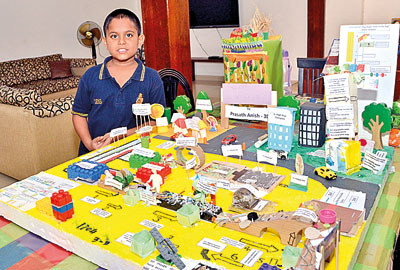A young environmentalist
View(s):Deeply moved was little Prasath Anish, by the tragic collapse of the Meethotamulla garbage dump that happened in April last year. For his seventh birthday in May last year Anish wanted to do something meaningful for the children affected by the disaster. With the help of his elocution teacher, Michael Joseph and friends, he donated preschool stationery to the Little Rose Nursery located in the area. “My parents took me to see the Meethotamulla garbage dump. I saw the people and all the broken houses,” Anish recalls.
It was a frequent sight at Anish’s residence at Lucky Plaza in Kollupitiya, garbage piled in the basement for days without a proper waste disposal plan.
Ideally when ‘Spark 2018’ exhibition was organized by the School Development Society with the Prefect’s Council 2017/18 of Royal College, Colombo, eight year old Anish, seeing all the garbage problems, had his own idea for his individual project to be presented at the exhibition.

Pic by M. D. Nissanka
As a result a waste management system designed for both residential areas and high rise apartment complexes came to be Anish’s project. A miniature model of the structure, set up on a Styrofoam board explains how his waste management system works. Anish was thoroughly knowledgeable and precise with his explanation of the process. “In a residential area, three bins are kept in green, blue and red for bio-degradable waste, recyclable waste and non-recyclable waste,” Anish explains. The waste goes through an underground pipeline system to the Biological Treatment Centre where a bag breaking machine will break the bags and send the bio-degradable waste to make compost. “Food scraps, garden waste — both brown and green waste would go through a grinding wheel to the compost beds,” he says.
Non-recyclable waste will be sent separately for landfilling and to produce landfilling gas as a source of energy.
Recyclable waste is sent to the Material Recycling/ Recovery Facility (MRF) for recycling. “Waste is sorted out manually, the fan drops small items to a separate bin, the glass breaker will break the glass and pieces put to another bin, magnetic separator will separate metal, optical scanner scans cardboard and plastic separator is separating 2D from 3D plastic,” Anish explains how the recyclable waste is sent for recycling.
In a high rise apartment complex, each floor has access to a garbage chute with a selection panel for bio-degradable, recyclable and non-recyclable waste. Rotating panel at the end of the chute is segregating garbage accordingly to three bins. A sensor system is attached to the collectors to indicate the height and weight of the waste.
“Less air pollution as there is no smell due to proper waste disposal, no flies, and animals cannot reach the garbage, are some of the advantages of this system,” Anish claims. As ‘Spark 2018’ was held from September 25 — 28 at the Royal College premises, Anish was busy with his project during the school vacation. “Shathurshini Akka visited us from Jaffna for holidays and helped me with origami houses,” he is grateful to his cousin sister for helping him to build the small paper houses of the model.
Paper, cardboard, plastic straws, building blocks, toy cars placed on the painted Styrofoam board are “all household waste and things that could be easily found,” Anish says. Anish’s waste management project is inspired by the similar projects which are already in effect in Scandinavian countries. “My mother showed me videos of how those systems operate in foreign countries and we collected information through the internet,” Anish claims.
Anish is grateful to his parents, grandparents, his cousins Nakshathra and Akshat for helping with the project, not forgetting his teachers at Royal College, specially his art teacher, Romiet Nicholas.
“My four year old brother Thevish helped me to clean up after the model was done,” Anish laughs. Setting an example like his project, Anish is involved in making compost at home and his family use the minimum of polythene and plastic at home.


